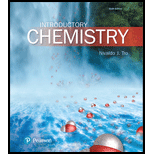
Concept explainers
Write the Lewis structure for each molecule.
a.
b.
c.
d.
Learn your wayIncludes step-by-step video

Chapter 10 Solutions
Introductory Chemistry (6th Edition)
Additional Science Textbook Solutions
Chemistry: Structure and Properties (2nd Edition)
General Chemistry: Principles and Modern Applications (11th Edition)
General Chemistry: Atoms First
Chemistry: Structure and Properties
Organic Chemistry (8th Edition)
General, Organic, and Biological Chemistry (3rd Edition)
- Draw the Lewis structure for the chlorine trifluoride (CIF3) molecule. Ċ C C X S 1 [] ?arrow_forwardConsider the compound xenon dichloride, XeCl2 a.What is the polarity of the molecule? b. What type of bond is the Xe-Cl bond? c. How many bonding pairs of electrons are there?arrow_forwardDraw the Lewis structure for a molecule of each of thesecompounds and ions.a. H 2 S c. S O 2b. B F 4 — d. SeC l 2arrow_forward
- 27. How many Jone-pair electrons are on each of the phosphorus atoms in the Lewis structure for diphosphorus tetroxide (P2O4)? Create the Lewis structure to help you answer the question. The phosphorus atoms are bonded to each other and to two oxygen atoms. The structure is not linear and does not have an expanded octet. c. 3 d. 1 a. b. 2arrow_forwardConsider the element Work (Wr) with an atomic number of 33 and an atomic mass of 81.03 g/mol. The following information was collected for this element Molecule/ Ion Names Wr-2 Workide WrO3-2 Workate WrO2-2 Workite WrO-3 hydroworkite a. Draw the Lewis structure of the molecule Workous acid and determine its electron geometry and molecular geometry. b.What is the mass % of work in Calcium hydroworkite.arrow_forwardThis thermodynamic cycle describes the formation of an ionic compound MX from a metal element M and nonmetal element X in their standard states. Based of the table (picture): A. What is the lattice enthalpy of MX? (in kJ/mol) B. What is the enthalpy of formation of MX? (in kJ/mol) C. Suppose both the electron affinity of X and the heat of sublimation of M were bigger. Would MX be more or less stable?arrow_forward
- What is lattice energy? A.Lattice energy is ionization energy + electron affinity/2 B.Lattice energy is the standard enthalpy of formation of an ionic solid C.Lattice energy is the energy needed for an ionic solid to dissolve D Lattice energy is the energy of formation of one mole of ionic solid from gaseous ionsarrow_forwardWhich physical change is endothermic? O A. CO2(t) - CO2(s) O B. CO2(g) - CO2(s) O C. CO2(s) – CO2(g) O D. CO2(g) - CO2(t)arrow_forwardDraw the Lewis structure for CH4O. b. Draw the Lewis structure for HNO2arrow_forward
- This thermodynamic cycle describes the formation of an ionic compound MX from a metal element M and nonmetal element X in their standard states. Based of the table (picture): A. What is the lattice enthalpy of MX2? (in kJ/mol) B. What is the enthalpy of formation of MX2? (in kJ/mol) C. Suppose the electron affinity of X were bigger and the heat of sublimation of M were smaller. Would MX2 be more or less stable? Or would it be impossible to tell without more information?arrow_forward81. Using the VSEPR theory, predict the molecular structure of each of the following molecules a. NCI3 b. H2Se c. SiCl4arrow_forwarda. Write the net ionic equation for the reaction. b. Do you expect the N-O bond in NO3- or NO to have a higher bond energy? Use Lewis structures to support your selection.arrow_forward
 Chemistry & Chemical ReactivityChemistryISBN:9781337399074Author:John C. Kotz, Paul M. Treichel, John Townsend, David TreichelPublisher:Cengage Learning
Chemistry & Chemical ReactivityChemistryISBN:9781337399074Author:John C. Kotz, Paul M. Treichel, John Townsend, David TreichelPublisher:Cengage Learning Chemistry & Chemical ReactivityChemistryISBN:9781133949640Author:John C. Kotz, Paul M. Treichel, John Townsend, David TreichelPublisher:Cengage Learning
Chemistry & Chemical ReactivityChemistryISBN:9781133949640Author:John C. Kotz, Paul M. Treichel, John Townsend, David TreichelPublisher:Cengage Learning

